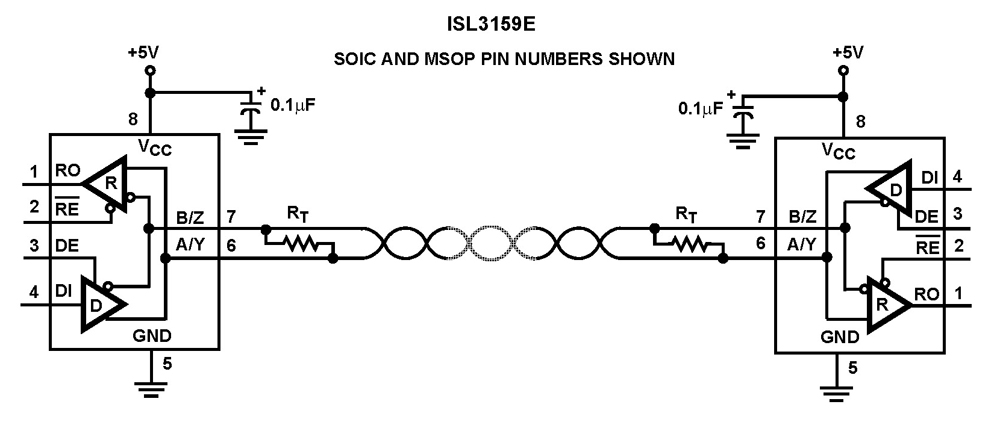Intersil’s ISL3159E is a ±15kV IEC61000 ESD protected, 5V powered, single transceiver that meets both the RS-485 and RS-422 standards for balanced communication. It also features the larger output voltage and higher data rate - up to 40Mbps - required by high speed PROFIBUS applications, and is offered in industrial and extended Industrial (-40°C to +125°C) temperature ranges. The low bus currents (+220µA/-150µA) present a “1/5 unit load” to the RS-485 bus. This allows up to 160 transceivers on the network without violating the RS-485 specification’s load limit and without using repeaters.
This transceiver requires a 5V ±10% tolerance supply, and delivers at least a 2.1V differential output voltage over this supply range. This translates into better noise immunity (data integrity), longer reach, or the ability to drive up to six 120Ω terminations in “star” or other nonstandard bus topologies, at the exceptional 40Mbps data rate.
SCSI applications benefit from the ISL3159’s low receiver and transmitter part-to-part skews, which make it perfect for high speed parallel applications where large numbers of bits must be simultaneously captured. The low bit-to-bit skew eases the timing constraints on the data latching signal.
Receiver (Rx) inputs feature a “full fail-safe” design, which ensures a logic high Rx output if Rx inputs are floating, shorted, or terminated but undriven. Rx outputs feature high drive levels (typically >30mA at VOL = 1V) to ease the design of optically isolated interfaces.
Hot plug circuitry ensures that the Tx and Rx outputs remain in a high impedance state while the power supply stabilizes.
Driver (Tx) outputs are short-circuit protected, even for voltages exceeding the power supply voltage. Additionally, on-chip thermal shutdown circuitry disables the Tx outputs to prevent damage if power dissipation becomes excessive.
Key Features
- IEC61000 ESD protection on RS-485 I/O Pins: ±15kV
- Class 3 HBM ESD level on all other pins: >9kV
- Large differential VOUT: 2.8V into 54Ω Better noise immunity, or drive up to 6 terminations
- High data rates: up to 40Mbps
- Specified for +125°C operation
- 11/13ns (max) Tx/Rx propagation delays; 1.5ns (max) skew
- 1/5 unit load allows up to 160 devices on the bus
- Full fail-safe (open, shorted, terminated/undriven) receiver
- High Rx IOL to drive optocouplers for isolated applications
- Hot plug - Tx and Rx outputs remain three-state during power-up
- Low quiescent supply current: 4mA
- Low current shutdown mode: 1µA
- -7V to +12V common-mode input voltage range
- Three-state Rx and Tx outputs
- Operates from a single +5V supply (10% tolerance)
- Current limiting and thermal shutdown for driver overload protection
- Pb-free (RoHS compliant)
Applications
- PROFIBUS DP and FMS networks
- SCSI “fast 40” drivers and receivers
- Motor controller/position encoder systems
- Factory automation
- Field bus networks
- Security networks
- Building environmental control systems
- Industrial/process control networks

Order Information| Part Number | Package Type | Weight(g) | Pins | MSL Rating | Peak Temp (°C) | RoHS Status |
|---|
|
| ISL3159EFBZ | 8 Ld SOIC | 0.076 | 8 | 3 | 260 | RoHS |
|
|
| ISL3159EFBZ-T | 8 Ld SOIC T+R | 0.076 | 8 | 3 | 260 | RoHS |
|
|
| ISL3159EFRZ | 10 Ld DFN | 0.022 | 10 | 3 | 260 | RoHS |
|
|
| ISL3159EFRZ-T | 10 Ld DFN T+R | 0.022 | 10 | 3 | 260 | RoHS |
|
|
| ISL3159EFUZ | 8 Ld MSOP | 0.025 | 8 | 2 | 260 | RoHS |
|
|
| ISL3159EFUZ-T | 8 Ld MSOP T+R | 0.025 | 8 | 2 | 260 | RoHS |
|
|
| ISL3159EIBZ | 8 Ld SOIC | 0.076 | 8 | 3 | 260 | RoHS |
|
|
| ISL3159EIBZ-T | 8 Ld SOIC T+R | 0.076 | 8 | 3 | 260 | RoHS |
|
|
| ISL3159EIRZ | 10 Ld DFN | 0.022 | 10 | 3 | 260 | RoHS |
|
|
| ISL3159EIRZ-T | 10 Ld DFN T+R | 0.022 | 10 | 3 | 260 | RoHS |
|
|
| ISL3159EIUZ | 8 Ld MSOP | 0.025 | 8 | 2 | 260 | RoHS |
|
|
| ISL3159EIUZ-T | 8 Ld MSOP T+R | 0.025 | 8 | 2 | 260 | RoHS |
|
|
| ISL3159EFBZ-T7A | 8 Ld SOIC T+R | 0.076 | 8 | 3 | 260 | RoHS |
|
|
| ISL3159EFRZ-T7A | 10 Ld DFN T+R | 0.022 | 10 | 3 | 260 | RoHS |
|
|
| ISL3159EFUZ-T7A | 8 Ld MSOP T+R | 0.025 | 8 | 2 | 260 | RoHS |
|
|
| ISL3159EIBZ-T7A | 8 Ld SOIC T+R | 0.076 | 8 | 3 | 260 | RoHS |
|
|
| ISL3159EIRZ-T7A | 10 Ld DFN T+R | 0.022 | 10 | 3 | 260 | RoHS |
|
|
| ISL3159EIUZ-T7A | 8 Ld MSOP T+R | 0.025 | 8 | 2 | 260 | RoHS |
|
|

